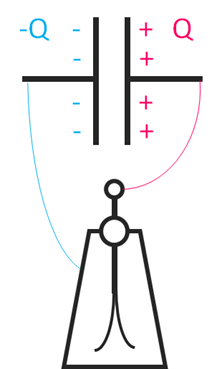I was reading Feynman's lecture 10 on the Lessons on Physics vol. 2 book, in which he talks about dielectrics.
https://www.feynmanlectures.caltech.edu/II_10.html
(...) However, using a simple electroscope and a parallel-plate capacitor, Faraday discovered that this was not so. His experiments showed that the capacitance of such a capacitor is increased when an insulator is put between the plates. (...)
I'm trying to understand Faraday's experiment with a capacitor and an electroscope.
Let's say I have a capacitor charged with charge Q.
And then I connect an electroscope in parallel with the capacitor.
Since both are conductors and connected to each other, the charges will redistribute among them until both reach the same electric potential.
Now comes the part that gets me confused, when we insert a dielectric between the capacitor's plates.
To my understanding, $C1$, which is the capacitor's capacity, is given by
$$ C1 = \frac{Q1}{V} $$
and, since we know experimentally that $C1$ increases, then we can deduce that either $Q1$ increases or $V$ goes down.
We know for sure that $V$ goes down. And, since both the capacitor and the electroscope are at the same electric potential, then $V'$ (smaller $V$) is the same for both.
But Feynman says that Faraday found experimentally that the electroscope's reading goes down! Therefore, charge $Q2$ has to decrease (because it's the charge on the electroscope) and $Q1$ has to increase to such a ratio that
$$ V' = \frac{Q1'}{C1'} = \frac{Q2'}{C2'} $$
still holds true.
Therefore, $Q1$ absolutelly is going to change, as will $Q2$. It doesn't stay constant, even though $V$ has changed.
Is my reasoning correct? Because at the lecture Feynman says that $Q$ stays constant, but I guess in his hypotetical example there's no electroscope attached to the capacitor.






